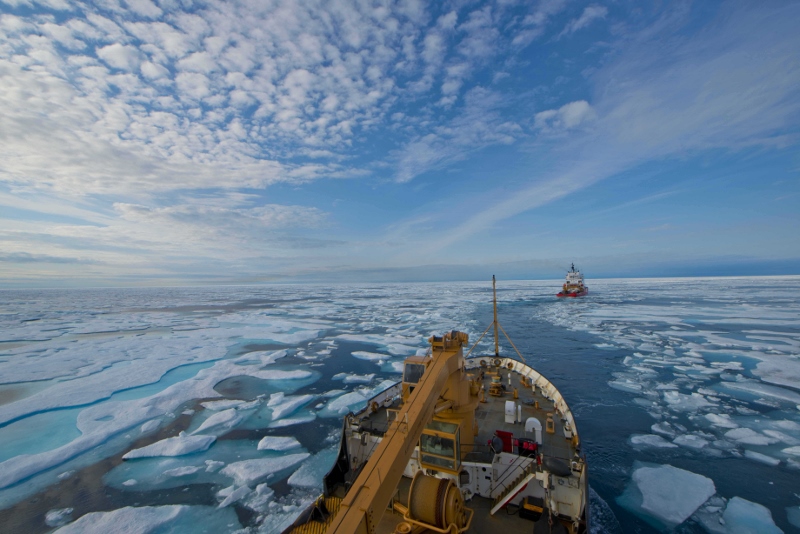This summer’s research cruises to the Arctic and Northwest Passage marked new milestones for the Coast Guard, amid growing interest in the region’s maritime potential and momentum building for a new U.S. icebreaker fleet.
The 420’ medium icebreaker Healy’s annual summer science voyage to the North Pole was notable for the first Coast Guard dive team to operate under the ice in 11 years. The exercise was the first since a 2006 accident cost two divers their lives, and led to widespread review and reform on Coast Guard dive procedures.
An onboard memorial service was held for divers Lt. Jessica Hill and Petty Officer 2nd Class Stephen Duque. Then dry suited divers went deep under the ice, and swam alongside the Healy. Arctic dive operations capability for ship repair, scientific research and search and rescue will be critical for an expanded U.S. polar fleet.

Coast Guard Petty Officer 1st Class Brendon Ballard enters the water from a Coast Guard cutter Healy small boat during a cold water ice dive in the Arctic on July 30. U.S. Coast Guard photo/PO2 Meredith Manning.
Meanwhile, the cutter Maple, a 225’x46’x13’ Juniper-class seagoing buoy tender, departed her homeport of Sitka, Alaska, on a transit for the Coast Guard yard at Baltimore, Md. – via the Northwest Passage.
The Maple’s voyage marked the 60th anniversary of the deep-draft charting of the Northwest Passage by U.S. and Canadian coast guard crews. On its eastward passage, accompanied by the Canadian coast guard vessel Sir Wilfred Laurie and the icebreaker Terry Fox, the Maple carried a marine mammal researcher from the Scripps Oceanographic Institute, San Diego.
Arriving at Nome, Alaska, July 19, the Maple took on retired Canadian coast guard Capt. Marc Rothwell, an experienced ice navigator since 1982. On July 24, they encountered the first floating ice field in dense fog, 100 miles east of Barrow.
The Maple entered the Northwest Passage region Aug. 3, and in the following days navigated the Bellot Strait with her Canadian companions. Along the way, they met up with another Canadian icebreaker, the 300’ Amundsen, carrying scientists from Quebec’s Université Laval, and took on fuel.

Coast Guard Cutter Maple crew member Seaman Jeffery Moore keeps lookout from the bridge as the Maple follows Canadian Icebreaker Terry Fox into Bellot Strait in Nunavut, Canada, August 12, 2017. U.S. Coast Guard/PO2 Nate Littlejohn.
In the preceding weeks, Finland’s state-owned 380.5’x85.3’ multipurpose tug/icebreaker Nordica made a record setting earliest Northwest Passage transit, departing July 2 from Vancouver, British Columbia, and arriving at Nuuk, Greenland, July 29.
Operators Arctica Ltd. undertook the international expedition to mark the 100th anniversary of Finnish independence, and the nation’s new role in chairmanship of the international Arctic Council. The ship’s company included scientists and Cdr. Bill Woityra, the ice operations division chief for the U.S. Coast Guard, and a reporting team from the Associated Press.
The Amundsen likewise carried a team from the Washington Post, documenting how scientists and maritime officials are preparing for a warming Arctic with potentially more human activity in navigation and resource development.
Coast Guard officials noted another significant date this week: the anniversary of the Polar Sea and Canadian coast guard heavy icebreaker Louis S. Ste. Laurent steaming together to become “the first North American surface ships to reach the North Pole” on Aug. 22, 1994. A Coast Guard HH-65A helicopter, detached from the Aviation Training Center Mobile in Alabama to the Polar Sea, became the first U.S. helicopter at the North Pole as well.

The Finnish icebreaking tug Nordica set a record for the earliest Northwest Passage transit in July. Arctica Ltd. photo.
Since that 1994 voyage, implications of climate change in the Arctic have focused more attention on the top of the world than since the Cold War, when the Soviet Union and U.S. allies vied for strategic knowledge and operational capability.
The first naval transit of the North Pole was by the U.S. nuclear submarine Nautilus in August 1958, and it would not be until 1977 when the Soviet nuclear icebreaker Arktika became the first surface ship to reach the Pole. With U.S.-Russia relations increasingly tense, those military dimensions are slowly beginning to emerge again.
No one in Hollywood is doing a remake of the 1968 potboiler Ice Station Zebra without the ice, just yet. But last month Coast Guard commandant Adm. Paul Zunkuft told members of Congress that Russia is clearly moving in that direction.
Speaking to the House Subcommittee on Coast Guard and Maritime Transportation, Zukunft said Russia is expanding its icebreaker fleet – to include two icebreaking corvettes with cruise missile capability – claiming its extended continental shelf to nearly the North Pole, and “militarizing search and rescue stations.”




